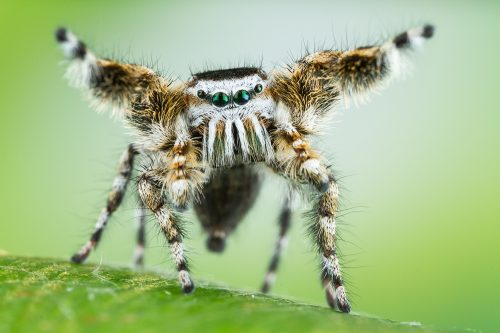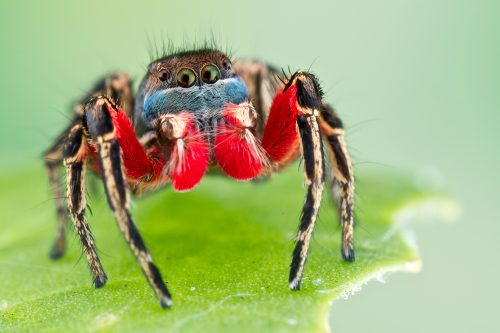GAINESVILLE, Fla. — Visitors to the Florida Museum of Natural History can learn about the foot-tapping mating rituals of spiders in the new “Colorful Dancing Spiders” exhibit.
Stunning images showcase the vivid colors and beauty of tiny jumping spiders, some of which are smaller than a Q-tip. Videos of assistant research scientist Lisa Taylor from the University of Florida’s Taylor Lab go into more detail about the arachnids’ unique dances and spider research at the entomology and nematology department. Display cases highlight some of the tools and experiments scientists use to learn about their mating and feeding habits, including distinctive tests involving makeup, paints and toothpicks.

One experiment saw researchers use black eyeliner to paint over the bright colors on male jumping spiders to understand the role of color in mating. These spiders’ fascinating courtship displays have a surprising amount of choreography and panache, even drawing comparisons to birds.
“The genus Habronattus, which is featured heavily in the exhibit, has the common name ‘paradise spiders’, after the birds of paradise,” Taylor said. “The males’ display to females uses a combination of color, motion and sound — people just don’t notice them because all of this drama happens underfoot, mostly in the leaf litter or grass.”
Usually, only males are brightly colored, and the individuals with the best genes or in the best health will produce the brightest colors. The female spiders, who tend to be brown and gray to blend in with their surroundings, are choosy and will only allow a male to approach after being impressed by a dance.

“One of my favorite things is creating exhibits with scientists to uncover the mystery behind their research,” said exhibit developer Tina Choe. “Once you see spiders up close, you might be surprised at the beauty and fascinating behavior going on right under our noses. Who knows? You might become a spider saver like me!”
Like humans, these spiders are highly visual creatures and use their large, forward-facing eyes to find mates as well as to hunt. Despite their tiny size, they are voracious predators with exceptional vision and hunt mosquitoes, fruit flies, small cockroaches and garden pests.
“Even though their brains and sensory systems are so different than ours, there is something about two big eyes peering at you that makes them easy to connect with, as if they were tiny, fuzzy, charming vertebrates rather than spiders,” Taylor said. “Wonderful, natural and adorable pest control.”
“Colorful Dancing Spiders” will be on display through the end of 2023. For more information, visit www.floridamuseum.ufl.edu/exhibits/colorful-dancing-spiders.
-30-
Writer: Nikhil Srinivasan, nsrinivasan@floridamuseum.ufl.edu
Sources: Tina Choe, tchoe@floridamuseum.ufl.edu; Lisa Taylor, lisa.taylor@ufl.edu
Media Contact: Kaitlin Gardiner, kgardiner@floridamuseum.ufl.edu